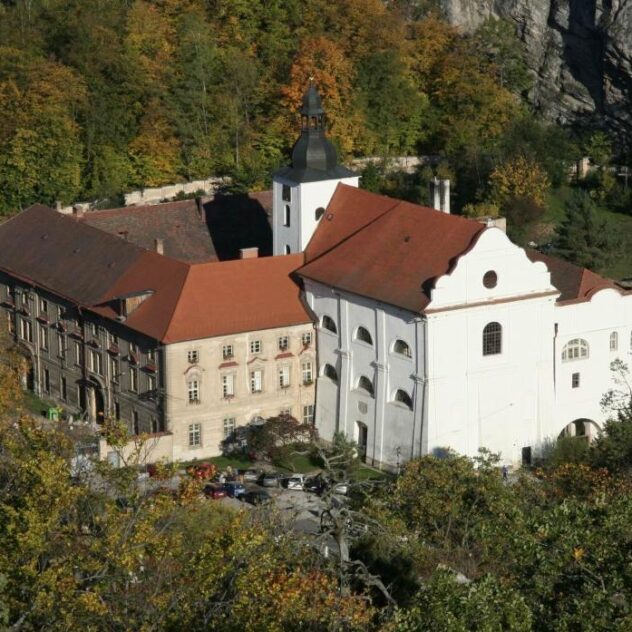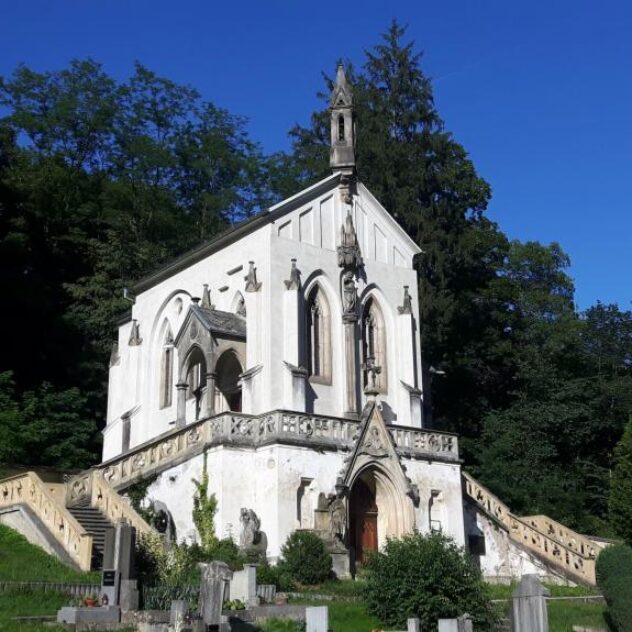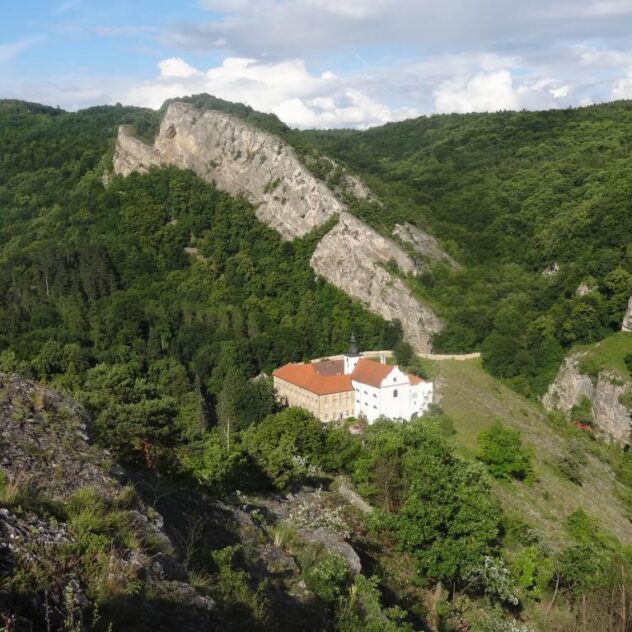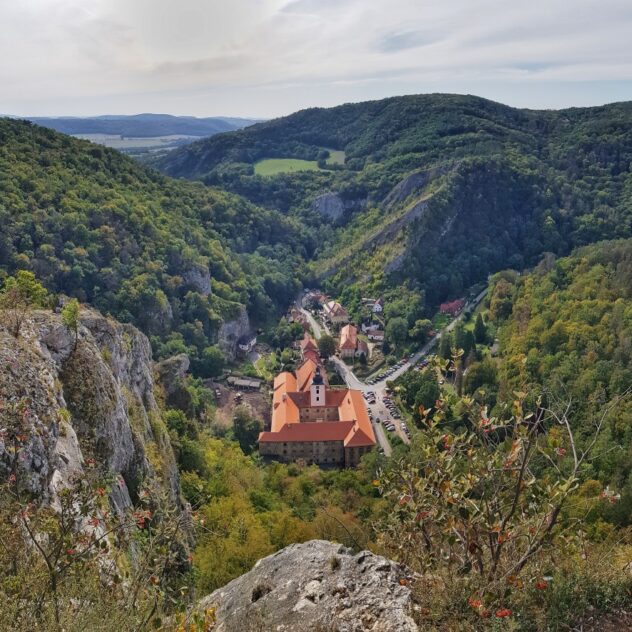St. John under the Rock
Information about the pilgrimage site
The popular pilgrimage site of Svatý Jan pod Skalou can be found in the protected landscape area of the Bohemian Karst. It was founded near a cave with a spring, where later a monastery complex grew. The first written mention of the hermit Ivan’s cave can be found in a charter of King Přemysl Otakar I in 1205. The Church of the Nativity of St. John the Baptist was a Baroque building from 1657-61, built by the architect Carl Lurag and later modified by K. Dientzenhofer. In the centre of the church is a sarcophagus with the remains of Blessed Ivan, a rare marble baptismal font from 1576 and a large wooden cross that originally stood on Charles Bridge in Prague. Directly in the church is the entrance to the hermit’s cave where St. Ivan used to live. After the construction of the church, a Baroque monastery began to be built, which was completed in 1735 and later rebuilt. Its turbulent fate after the abolition of the monasteries by Joseph II was not easy. It served as a manufactory, a nobleman’s residence, St. John’s Baths, a teachers’ institute and, under the Communists, a forced labour camp and a prison. Since 1994 it has been the seat of the Higher Vocational School of Education with St. John’s College. The pilgrimage complex and the small village are located under the dominant rock that gave the place its name.
Legend has it that this cave was inhabited in the 10th century by the hermit Ivan, who was tempted by evil demons and wanted to leave the place. On his way out, St. John the Baptist appeared to him and gave him a wooden cross, and Ivan banished the evil spirits. He was then able to return to the cave. The cave includes a massive mineral spring which springs up here and to which people attributed healing powers. Today, there is a separate access to the spring, and people can rest and drink from the spring of St. Ivan. Devotions and pilgrimages on the feast of St. John the Baptist 24.6.
Tourist attractions in the vicinity
Karlstejn Castle – the most visited and most famous Czech castle Karlstejn was founded by Emperor Charles IV in the 14th century for the safe storage of the crown jewels. In the 17th century, after the removal of the jewels, the castle lost its importance and fell into disrepair. The most valuable thing the castle contains is the Gothic Chapel of the Holy Cross. This beautiful space, whose artistic value goes beyond the borders of Bohemia, preserves 127 panel paintings of saints by the master Theodoric from 1357-1363. It is lined with semi-precious stones arranged in the shape of crosses. The castle is 11 km away from the pilgrimage site. For more information visit https://www.hrad-karlstejn.cz/cs .
Beroun – the town of Beroun has a rich history. It was founded in the 13th century at the confluence of the rivers Berounka and Litavka. The remains of the walls from the time of the town’s foundation have been preserved in the town with two gates, the lower Pražská and Plzeňská, which has been rebuilt in the Baroque style. The dean’s church of St. James dates back to the time of the town’s foundation and was later rebuilt. There are valuable town houses on the square. The distance from Svatý Jan pod Skalou is 9 km. For more information visit https://www.mesto-beroun.cz/o-beroune/pamatky/13-kostel-sv-jakuba-0_676.html .
Koněprus Caves – in the protected landscape area of the Bohemian Karst, the largest cave system in the Czech Republic – the Koněprus Caves – is worth a visit. These cave spaces have always been inhabited and with their stalactites and pools form an admirable place. The distance from the pilgrimage site is 20 km. For more information visit https://konepruske.caves.cz/ .
Tetín – one of the oldest settlements in our country Tetín is situated on the right bank of the Berounka River. This place of pilgrimage is known especially in connection with the murder of St. Ludmila, the grandmother of St. Wenceslas. There are three churches on the site, the oldest is St. Catherine’s Church from the 12th century, in its neighbourhood there is St. Ludmila’s Church from the 17th century. The third church of St. John of Nepomuk, Romanesque in its core, Baroque in its present form, is said to stand over the original grave of St. Ludmilla. More information at https://www.tetin.cz .
Mníšek pod Brdy-Skalka – above the town of Mníšek pod Brdy, where a nice chateau stands, we can find the romantic pilgrimage site Skalka. The owner of the estate had the chapel of St. Mary Magdalene, a hermitage, a cross road with chapels and later a small monastery built here in the 17th century. The site has been restored and is 27 km away from St. John under the Rock.
https://www.mnisek.cz/pamatky/barokni-areal-skalka/
Other tourist attractions in the area can be found on the website:
Accommodation
- The village is small and very popular with tourists, we recommend to arrange accommodation in the nearby town of Beroun, more at https://www.svatyjan.cz/turistika-volny-cas/obcerstveni-a-ubytovani/
- Other private accommodation in the vicinity of the pilgrimage site
Availability
By car
Svatý Jan pod Skalou is accessible by car, parking is limited, so it is a good idea to consider other means of transport.
By public transport
The site is accessible by bus and train. For up-to-date information on public transport, please visit the homepage. Details of connections can be checked at www.idos.cz.
On foot
The place is located on marked tourist routes, the European St. James route Iron to Santiago de Compostela passes here. For orientation you can use the markings of the Czech Tourist Club in the field or www.mapy.cz.
On a bicycle
The area of Svatý Jan pod Skalou is very accessible also on bicycles. In addition, the town of Beroun provides electric bike rental, more information can be found on the homepage.








